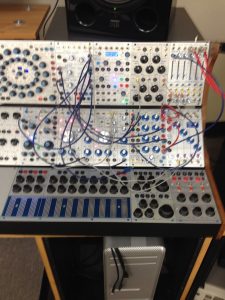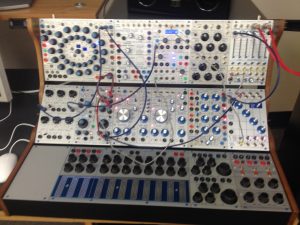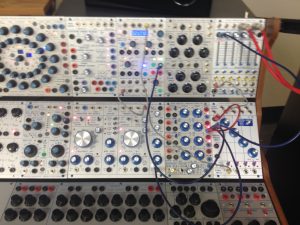This piece, inspired in part by Terry Riley‘s Rainbow in Curved Air, consists of 4 continuous tracks layered on top of one another.
Track/Patch 1

The first patch, originally conceived as an attempt at Krell Patching which fell short, became a sort of blanket or foundation for the rest of the piece. It consists of three sound sources: one from the principal oscillator on the 259 and 259e respectively, run into the 292C, as well as a noise source from the 266. The two sounds of the 259 and 259e are somewhat randomized by the 281 as their attack and decay settings are being voltage controlled by various random voltages coming from the 266, as well as pitch and timbre. The noise source is being sent through the filter to produce a pitch approximate to that coming from the two oscillators (when not effected by pitch modulation).

The second patch is a sound source from the 259e which is run through the 250 sequencer. It begins with a loop to stage four, then to five, six, seven, and 8, before returning to only 4 stages of looping at the end of the piece. It is tuned to a series of notes which doesn’t change do-mi-so-te-do-me-fa-fi (in movable do). This provides a rhythmic driving feel for the composition as well as shifts in metric feel. The 291e filter was used to mitigate some of the amplitude issues, by using the adder to reduce the voltage amount as the notes ascend in pitch (wherein they would become too loud relative to the lower notes of the sequence).

The third patch was easiest to produce, and consisted of a single low frequency which is filtered by the 291e using the morphing stages to sweep up and down a fixed range of harmonics using the frequency controls. The 281 and 292 were used to produce its envelope shape.

The fourth and final patch focuses on the 216, used to effect the pitch of a sound-source from the 259’s principal oscillator. The first row of CV’s was used to tune the keyboard to the “blues” scale. Notes of the scale are introduced gradually throughout the piece as they are heard in the sequence generated by the 250 in the second patch. The 281 was used to generate an envelope for the timbre modulation effecting the 259’s principal oscillator. The modulation oscillator is amplitude modulating the principal and a random voltage from the 266 is used to modulate the pitch of the modulation oscillator. A few times in the piece, while I was performing this track (which took many attempts, mind) I turned the pitch modulation pot on the modulation oscillator to produce dissonant and chaotic sounds, usually timed loosely with the low droning pitch of the third patch.
The title is a sort of play on words, as this groovy piece is performed on an instrument designed by the one and only Don Buchla.